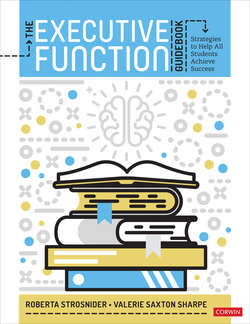Читать книгу The Executive Function Guidebook - Roberta Strosnider - Страница 17
На сайте Литреса книга снята с продажи.
Considering Executive Functions, Metacognition, UDL, and Learning
ОглавлениеFigure 1.5 outlines the considerations that both the teacher and student should address when addressing executive functions, metacognition, UDL, and learning. Both have specific elements that must be reflected upon when determining which strategy is the best choice for the student, and the role of the teacher and the student in the strategy selection process (see figure 1.5).
FIGURE 1.5 Teacher−Student Roles While Considering Executive Functions, Metacognition, UDL, and Learning
This is how one teacher encourages her students to use metacognition.
Teacher Testimonial from: Batya Toso
Special Educator
Grade(s) Taught: K, 4th, and 5th
Strategy Name: Cognitive/Metacognitive Strategy Instruction
Strategy Designed for: Small group
Batya Toso
Students with disabilities were introduced to the strategy in a regularly occurring small group intervention outside the general education classroom. The two interventions were to target reading comprehension and mathematical thinking and problem solving. Initially students were taught the basic components of learning, as well as metacognition. Students were also taught the steps of learning or task completion using a Plan−Monitor−Evaluate framework. During the introduction phase, I modeled the process, had students practice the process, and identified the components as they arose.
Once students easily identified where in their learning these metacognitive components took place, I introduced them to metacognitive questions related to each component. For instance, a question relating to task knowledge could be, “What materials or resources do I need?” A possible question for strategy knowledge is, “Is the strategy I’m using working?” Students then collaboratively sorted the metacognitive questions under the headers Personal Knowledge, Task Knowledge, and Strategy Knowledge. Finally, students discussed which questions were appropriate during the Plan stage, the Monitor stage, and the Evaluate stage of learning.
Students were then introduced to a bookmark containing a checklist encompassing each component of metacognition within the Plan−Monitor−Evaluate framework. In the beginning lessons I modeled and did Think-Alouds using the bookmark several times, together with a cloze format of guiding questions to help students come up with other questions that may be appropriate. Students then practiced use of the bookmark. The bookmark was reviewed each day and throughout the lesson as a method of ensuring we were on task; students were gradually given greater responsibility answering the questions themselves.
To help students further internalize this learning structure I made sure that any anchor charts I created followed the Plan−Monitor−Evaluate structure. For example, when focusing on the reading strategy of determining importance, I created an anchor chart listing each of the steps of the strategy under the Plan−Monitor−Evaluate headers:
Plan: What is my purpose for reading? What am I supposed to find out?
Monitor: Does what I’m reading match my purpose? Does this detail help me understand the main idea better?
Evaluate: Does the information I gathered meet my purpose? Can I summarize the most important parts of what I read?
After a six-week period, when students were more comfortable using the bookmark to guide their processes, the general education classroom teacher then began to use the bookmarks with the students during small groups.
